AI/ML
How to Build Trust in Remote Teams? 10 Best Ways
For a long time, enterprises around the world had feared going remote. But this change was pushed abruptly by a pandemic that forced them to rethink their work culture.
Several organizations, including Google, and Basecamp, have allowed employees to go fully remote.
Despite several benefits of working remotely, including better work-life balance, more productivity, and reduced commute times, the one downside remains a lack of trust or transparency.
This means organizations need to rethink how they build trust within the team.
This article takes you through actionable insights that can help you build trust in remote teams.
What’s the role of trust in remote work?
For businesses worldwide, remote and hybrid work has become the new norm. Trusting one another is crucial when a team works remotely and independently.
The divergence between managers and employees is frequently caused by a general lack of trust, accountability, and communication. Understanding the importance of trust for their performance is crucial for leaders who want to benefit from a hybrid workplace that promotes psychological safety. If you’re in charge, this can entail having faith in your team members to complete tasks and fulfill deadlines even when you can’t see them doing it.
Without this trust, there might be disagreements. When there is a lack of trust, some team members could feel overworked while others feel excluded. As a result, productivity and production may deteriorate with time.
What is a High Trust Culture? Why Do Enterprise Remote Teams Need It?
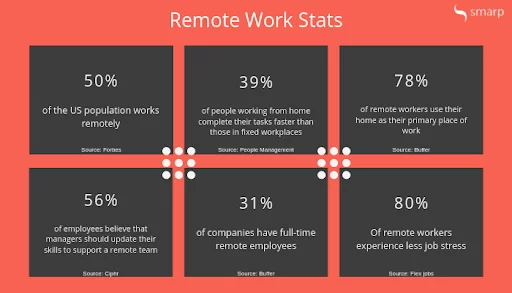
Trust plays an essential role in employee engagement.
Just think, would your employee work with you if they didn’t trust you?
A high trust culture is where the enterprise culture is built on the foundation of consistently building trust and trust-enhancing behaviors.
Benefits of High Trust Culture
-
Less attrition rate:
A study suggested that working in high trust culture reduced employee turnover to just 10%.
-
More productivity:
HBR study reported that people at high-trust companies say 50% higher productivity compared to low-trust ones.
-
Acts as a catalyst for high performance:
When everyone in the team trusts each other, conflicts go down significantly, which reduces emotional drainage so they can give more attention to work.
10 Ways Enterprise Build Trust in Remote Team
1. Hire The Right People: Not Everyone is Cut Out To Work Remotely
Before you go on your way to building trust in remote teams, it’s crucial to hire the right people. Why? Because not everyone is cut out to work remotely.
The same employee who can do well in an office environment will start underperforming in a remote environment simply because they are not cut out for it.
Here are a few tips to know whether the employee is suitable for remote work:
- Check both written and oral communication skills via interview calls to ensure that the virtual communication is well.
- Ensure to look for characteristics that the candidate is self-motivated, organized, and responsive.
- Should understand the challenges of working remotely and thus adapt to new changes quickly.

Companies like Vervoe offer software that allows you to screen candidates based on skills, allowing you to spend less time filtering candidates and more time focusing on high-touch work.
This way, you ensure that hiring the right candidate who is well versed in building trust in the later stage would be feasible.
2. Maintain Regular Communication and Transparency
Regular and transparent communication is the foundation of a successful remote team.
Remember, unlike office settings where coworkers are just a few meters away, remote teams are spread over the globe. This means it’s hard to get updates on what is happening around the office.
To remedy this, enterprises can send out regular organization news and events happening within so that employees know that they are in. Moreover, statistics say that over 85% of employees feel motivated when they get regular updates from the company.
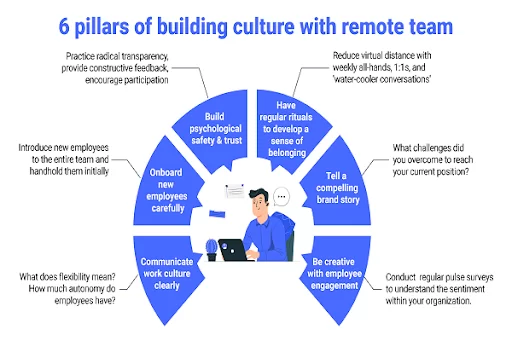
Organizations need to understand work-life balance; for that, leaders must be empathetic while communicating with remote teams. A study suggests that 60% of large enterprises will switch to smartphone applications to ensure work-life balance.
Also, follow the below tips to ensure the trust is maintained:
- Avoid sharing passive information.
- Foster agile work cultures.
- Maintain a flat hierarchy.
- Offer open communication platforms.
- With responsibility, share authority too.
- Foster team collaborations.
3. Mistakes Happen. Embrace Them.
It doesn’t matter how much you plan; mistakes are bound to happen. Your team members are humans and will make errors. So instead of scolding, or blaming them for mistakes, embrace them. This will help your remote team to get rid of anxiety where all they would think is what if something goes wrong.
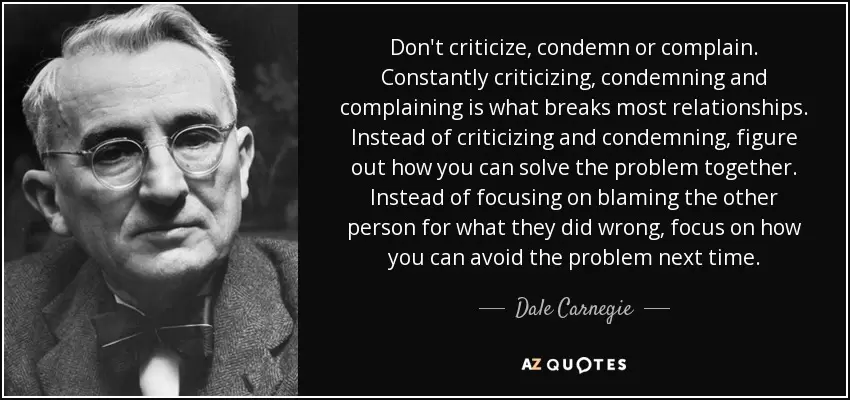
How To Handle Mistakes? Here Are A Few Tips:
-
Don’t Jump To Conclusions:
If mistakes happen, listen closely to what your team members say. Not only will this show that you trust them, but it will also give you critical information that will help you prevent such a situation in the future.
-
Guide, Don’t Criticize:
Instead of fixing your team’s mistakes, guide them so they can improve their own mistakes. It would help them trust you and be comfortable asking for your help when needed.
In an interview, Paul Schoemaker, the co-author of Brilliant Mistakes, says that employers should do a cost-benefit analysis of mistakes. One should ask:
“Are the mistakes going to cost a lot, or will they be beneficial in terms of high learning?” Accordingly, decide how to deal with your employees who made a mistake.
4. Appreciate & Praise To Keep Them Motivated!
From a leader or a manager, employees expect to appraise them for their hard work, which directly impacts trust and respect.
After all, stick management is now a thing of the past! The new in is the Carrot Principle, through which employers should learn about several proven strategies to motivate employees to offer high commitments and values to the company.

In the book The Carrot Principle, the author proposes that:
Rewarding employees meaningfully increases trust, drives engagement, and reduces churn.
Popular ways to keep employees motivated and earn trust are:
- Express gratitude
- Give team rewards
- Offer fitness opportunities
- Give time offs and happy-hours
- Encourage feedbacks
- Plan upskilling sessions
- Celebrate birthdays, anniversaries, and milestones
5. Define Goals & Rulebook To Omit Misinterpretation
Goals are critical to a successful team as goals drive team members to one common destination. This is even more important in remote teams where people feel geographically disconnected from each other.
For this, several companies go for virtual scrum calls as Scrum meetings help set goals.
As quoted by Jeff Sutherland in a Ted Talk – Scrum: How to do twice as much in half the time:
“Scrum meetings are not for self-reporting. The goal is to actively improve your teams’ goals.”
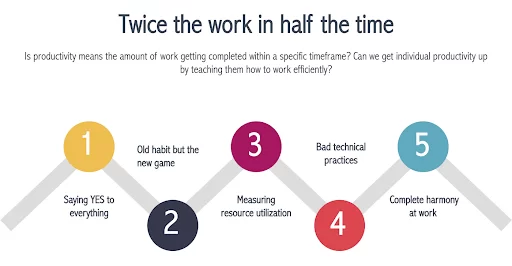
Working remotely or working from home has blurred the lines between professional and personal lives, making it hard to prioritize. That’s why goals can help your remote team work for one purpose.
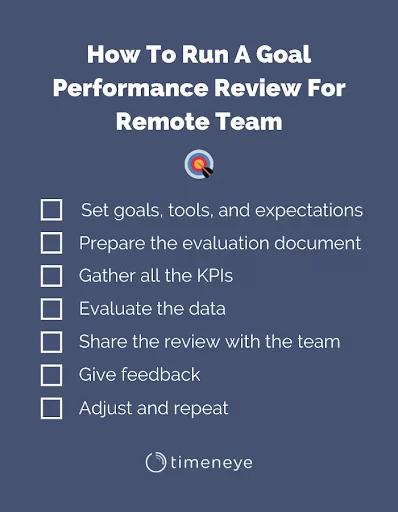
This reduces conflicts as team members know what to expect and thus leaves no room for misunderstandings.
6. Manage Conflicts Instead Of Avoiding Them

It’s impossible to avoid conflicts in the work environment, especially in remote teams. Disagreements are bound to happen when you take the team out of the office.
One wrong message on Slack can result in a fight among members.
However, things have turned here, and all the members are spread around the globe. There is no chance for face-to-face reconciliation, which is suggested in the Thomas-Kilmann Conflict Mode Instrument.
If not managed properly, it can create misunderstandings that can erode trust.
Here’s how to solve the conflicts.
- Understand the reason for conflict: There are several reasons why conflict occurs. This includes communication gaps, differences in work styles, task conflicts, etc. Understanding them could give you a solution to solve them.
- Handle issues immediately. The more your organization avoids conflicts, the harder it would be to mend the trust.
7. Ensure Everyone Knows They Are Accountable For Their Actions
“Anyone holding themselves accountable to nobody ought not to be trusted by anybody.” – Thomas Paine
In remote working environments, managers and team leaders rarely see what employees do. This means managers and leaders must keep faith in the team that everyone is working as expected.
Accountability is an essential element in a remote team. And teaching it to your employees means stronger relationships and better outcomes.
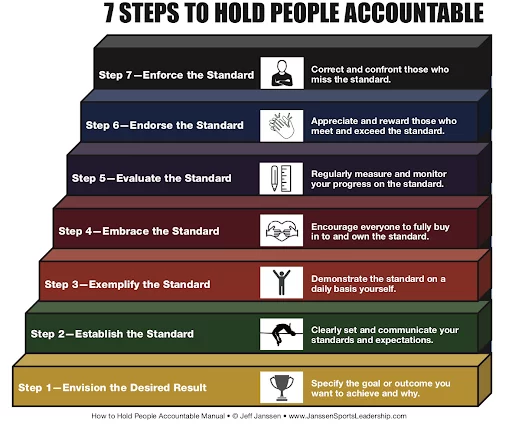
But how do enterprises build accountability in remote teams? Here are a few options.
- Held weekly meetings to check in on the team’s progress
- Ensure your team knows that the project is as must their responsibility as its organization.
8. Develop A Culture of Feedback
Peer-to-peer feedback is one of the best ways to create trust in a team.
As remote teams learn more about each other, each person can help others improve by giving feedback on co-workers’ work.
Not only does P2P feedback keep motivation high, but it also helps team members realign to improve how they work together.
However, it’s essential not to mix feedback systems with annual reviews that happen with managers. After all, whose feedback are you more likely to listen to? The manager you hardly worked with or coworkers you work with daily?
Enterprises can develop a feedback culture in two ways:
- Members can fill out the feedback form several times a year to give feedback to coworkers.
- Some organizations and leaders prefer training employees to give constructive criticism.
9. Focus On Outcomes
Although setting a timetable for online and offline activities is critical, it’s essential to remain not fixated on whether your team is working within the timeline or not.
Many employees would have a family to take care of when working from home, and as a result, they may get distracted sometimes or need some time off to manage emergencies.
What matters, in the end, is whether the team is delivering what they promised. Nowadays, several companies like RevenueCat, Panther, and Flowrite are focused on establishing async organization workflows which result in enhanced outcomes, among several other benefits.
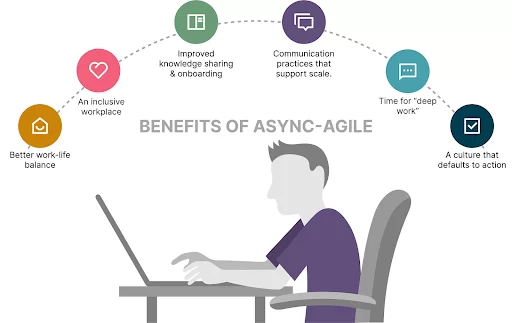
10. Host Virtual Retreat
Although most people glamorize remote working, it can be a lonely place for many. However, that doesn’t mean you can’t do anything.
What better way to build trust in your team than hosting a retreat? Even better, the retreat should be virtual, so they must travel worldwide to meet the team members.
In a blog, Frontastic, a commerce tools company, shared the story of the evolution of virtual retreats in their company.

For companies like Frontastic, a virtual retreat is not just meant for work; it’s also a way to socialize and establish trust, a vital aspect of the success of fully distributed teams.
Here are some interesting virtual retreat ideas to build trust in remote teams.
- Conduct A Happy Hour With Cocktail kits.
- Host An Icebreaker.
- Conduct A scavenger hunt.
- Host Employee Wellness sessions that include meditation, yoga, new habits, etc.
Trust and transparency instead of control
Trust and transparency between the members of the workplace are crucial to keeping a company running to the best revenue. Maintaining a relationship of trust and believing that your employee is on the same pace as you are important for fostering a healthy workplace.
Trust also entails having faith in an employee’s ability to make independent decisions that are best for their workflow. Under control, employees find it easier to gauge their performance and if they are fulfilling objectives. When a manager doesn’t trust them, employees don’t experience a feeling of success or accomplishment.
It’s significant to worry more about the outputs and less about the inputs. The key to managing a productive remote workforce is to empower them, not control them. Remote work aims to establish a relationship based on complete trust. This trust results from putting quality and output first rather than micromanaging the procedure or the number of hours put in.
Trust is the way to brilliant remote teams
Trust is built over time, and it takes consistent efforts to maintain. Follow the tips above to instill trust between your remote teams.
FAQs
- Why is trust important in virtual teams?
Trust is the foundation of successful remote teams. Research shows that employees working in high-trust enterprises are 70% less stressed and 50% more productive.As you can see, trust is built from both sides. Employees trust their organization to provide proper projects and equipment for work. On the other hand, organizations trust that their employees will commit to working on the tasks every day.
- How can enterprises create trust in a virtual setting?
There are several ways enterprises can create trust in virtual settings. A few of them are: - Maintain transparent and regular communication.
- Embrace mistakes. They will happen.
- Conduct retreats.
- Deliver timely, honest feedback.




